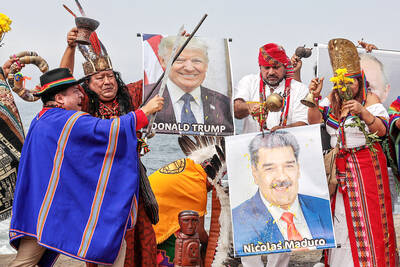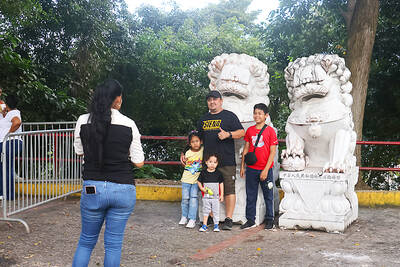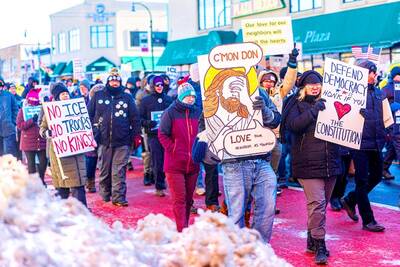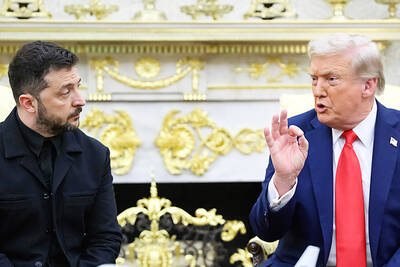Bae Kyung-mi was five years old when the US dropped the atomic bomb “Little Boy” on Hiroshima on Aug. 6, 1945.
Like thousands of other ethnic Koreans working in the city at the time, her family kept the horror a secret.
Many feared the stigma from doing menial work for colonial ruler Japan, and false rumors that radiation sickness was contagious.

Photo: AFP
Bae recalls hearing planes overhead while she was playing at her home in Hiroshima on that day. Within minutes, she was buried in rubble.
“I told my mom in Japanese: ‘Mom. There are airplanes,’” said Bae, now 85.
She passed out shortly after.
Her home collapsed on top of her, but the debris shielded her from the burns that killed tens of thousands of people — including her aunt and uncle.
After the family moved back to South Korea, they did not speak of their experience.
“I never told my husband that I was in Hiroshima and a victim of the bombing,” Bae said. “Back then, people often said you had married the wrong person if he or she was an atomic bombing survivor.”
Her two sons only learned she had been in Hiroshima when she registered at a special center set up in 1996 in Hapcheon, South Korea, for victims of the bombings, she said.
Bae said she feared her children would suffer from radiation-related illnesses that afflicted her, forcing her to have her ovaries and a breast removed because of the high cancer risk.
She knew why she was getting sick, but did not tell her own family.
“We all hushed it up,” she said.
About 740,000 people were killed or injured in the twin bombings of Hiroshima and Nagasaki.
More than 10 percent of the victims were Korean, data suggests, the result of huge flows of people to Japan while it colonized the Korean Peninsula.
Survivors who stayed in Japan found that they had to endure discrimination both as hibakusha, or atomic bomb survivors, and as Koreans.
Many Koreans also had to choose between pro-Pyongyang and pro-Seoul groups in Japan, after the peninsula was left divided by the 1950 to 1953 Korean War.
Kwon Joon-oh’s mother and father both survived the attack on Hiroshima.
The 76-year-old’s parents, like others of their generation, could only work by taking on “filthy and dangerous jobs” that the Japanese considered beneath them, he said.
Korean victims were also denied an official memorial for decades, with a cenotaph for them put up in the Hiroshima Peace Park only in the late 1990s.
Kim Hwa-ja was four on Aug. 6, 1945, and remembers being put on a makeshift horse-drawn trap as her family tried to flee Hiroshima after the bomb.
Smoke filled the air and the city was burning, she said, recalling how she peeped out from under a blanket covering her, and her mother screaming at her not to look.
Korean groups estimate that up to 50,000 Koreans could have been in the city that day, including tens of thousands working as forced laborers at military sites, but records are sketchy.
“The city office was devastated so completely that it wasn’t possible to track down clear records,” a Hiroshima official said.
Japan’s colonial policy banned the use of Korean names, further complicating record-keeping.
After the attacks, tens of thousands of Korean survivors moved back to their newly independent nation, but many have struggled with health issues and stigma ever since.
“In those days, there were unfounded rumors that radiation exposure could be contagious,” said Jeong Soo-won, director of the country’s Hapcheon Atomic Bomb Victim Center.
Nationwide, there are believed to be about 1,600 South Korean survivors still alive, Jeong said — with 82 of them in residence at the center.
Seoul enacted a special law in 2016 to help the survivors — including a monthly stipend of about US$72 — but it provides no assistance to their offspring or extended families.
“There are many second and third-generation descendants affected by the bombings and suffering from congenital illnesses,” Jeong said.
A provision to support them “must be included,” he said.
A Japanese hibakusha group won the Nobel Peace Prize last year in recognition of their efforts to show the world the horrors of nuclear war, but 80 years after the attacks, many survivors in both Japan and Korea say the world has not learned.
US President Donald Trump compared his strikes on Iran’s nuclear facilities to the bombing of Hiroshima and Nagasaki.
“Would he understand the tragedy of what the Hiroshima bombing has caused? Would he understand that of Nagasaki?” survivor Kim Gin-ho said.
In South Korea, the Hapcheon center is to hold a commemoration tomorrow — with survivors hoping that this year the event would attract more attention.
From politicians, “there has been only talk ... but no interest,” Kim Gin-ho said.

Shamans in Peru on Monday gathered for an annual New Year’s ritual where they made predictions for the year to come, including illness for US President Donald Trump and the downfall of Venezuelan President Nicolas Maduro. “The United States should prepare itself because Donald Trump will fall seriously ill,” Juan de Dios Garcia proclaimed as he gathered with other shamans on a beach in southern Lima, dressed in traditional Andean ponchos and headdresses, and sprinkling flowers on the sand. The shamans carried large posters of world leaders, over which they crossed swords and burned incense, some of which they stomped on. In this

Near the entrance to the Panama Canal, a monument to China’s contributions to the interoceanic waterway was torn down on Saturday night by order of local authorities. The move comes as US President Donald Trump has made threats in the past few months to retake control of the canal, claiming Beijing has too much influence in its operations. In a surprising move that has been criticized by leaders in Panama and China, the mayor’s office of the locality of Arraijan ordered the demolition of the monument built in 2004 to symbolize friendship between the countries. The mayor’s office said in

‘TRUMP’S LONG GAME’: Minnesota Governor Tim Walz said that while fraud was a serious issue, the US president was politicizing it to defund programs for Minnesotans US President Donald Trump’s administration on Tuesday said it was auditing immigration cases involving US citizens of Somalian origin to detect fraud that could lead to denaturalization, or revocation of citizenship, while also announcing a freeze of childcare funds to Minnesota and demanding an audit of some daycare centers. “Under US law, if an individual procures citizenship on a fraudulent basis, that is grounds for denaturalization,” US Department of Homeland Security Assistant Secretary Tricia McLaughlin said in a statement. Denaturalization cases are rare and can take years. About 11 cases were pursued per year between 1990 and 2017, the Immigrant Legal Resource

‘RADICALLY DIFFERENT’: The Kremlin said no accord would be reached if the new deal with Kyiv’s input did not remain within the limits fixed by the US and Russia in August Ukrainian President Volodymyr Zelenskiy is to meet US President Donald Trump in Florida this weekend, but Russia on Friday accused him and his EU backers of seeking to “torpedo” a US-brokered plan to stop the fighting. Today’s meeting to discuss new peace proposals comes amidst Trump’s intensified efforts to broker an agreement on Europe’s worst conflict since World War II. The latest plan is a 20-point proposal that would freeze the war on its current front line, but open the door for Ukraine to pull back troops from the east, where demilitarized buffer zones could be created, according to details revealed by